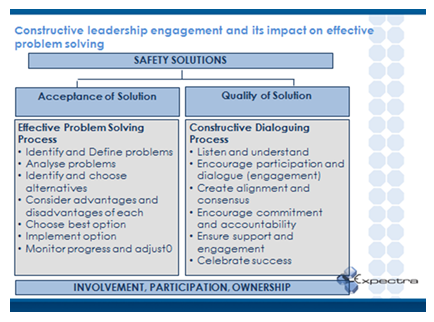Organisational Leadership can be described as the process of social influence in which one person can enlist the aid and support of others in the accomplishment of a common task or goal.
Safety leadership is about engagement at all levels in the organisation inter alia the effect that it will have on the organisation in terms of safety leadership impact, safety process & procedure execution and operational practice of safe behaviours.
A direct relationship exists between Leadership style and Safety Culture in an Organisation.
This Leadership approach is often clearly visible in how Organisations approach their decision making and problem solving regarding safety and risk i.e. how we identify and manage leading indicators through creating a reporting culture (the willingness of people to voluntarily report incidents without the fear of retribution) and whether we subsequently do get to the root causes of organisational incidents and failures through a Safety Culture of Engagement.
The leadership style will directly influence the effectiveness of problem solving techniques and identifying the root causes. The diagram below illustrates the relationship between effective problem solving and the leadership style, creating a constructive, interdependent leadership style.

Leadership can be defined as the capacity to influence others through inspiration. However, the ability of the leader to inspire comes from his/her own passion, conviction, vision and goals.
Leadership styles can be summarised into 3 main categories:
- Those leaders who inspire with an engaging leadership style, creating an interdependent culture where people want to perform at their best.
- Other leaders’ control (aggressive) their people, causing them to fear where they feel forced to perform.
- The third group of leaders are passive, forget to inspire at all, and people don’t want to perform.Whatever style the leader applies or lack applying has an impact on the rest of the team and determines the culture.
The influencing style of the leader will, therefore, have an impact on the rest of the team behaviour.
Trying to identify the individual “responsible” for the error/mistake/incident and then punish that individual, may result in some “reaction” from the team, e.g. not to mention names or not report incidents in future again.
They may even use it to compete against peers. The leader is therefore creating the environment conducive to the emerging of certain behaviours. These behaviours are often not supporting the Safety Vision of “Safe Making”.
The Safety Leadership Process aims to create awareness and dialogue around the influencing style of leaders as well as indicating the balance between engaging, aggressive, and passive influencing behaviour. An engaging, interdependent style from the leader mainly breeds interdependent, performing behaviour from the team; an aggressive style from the leader mainly breeds dependent, sometimes sabotaging behaviour from team members and a passive leadership style leads to passivity.
The diagram below clearly illustrates the relationship between effective problem solving (i.e. seeking the root causes of the organisational failure/incidents) and the leadership style, creating an engaging, interdependent culture.










